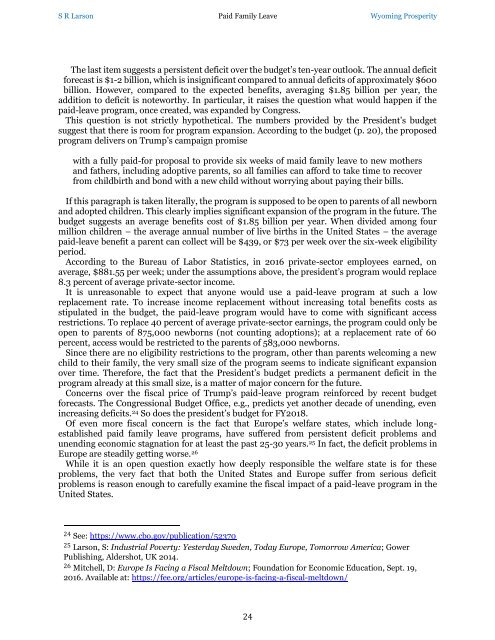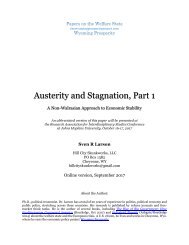Welfare State Paper 1 Paid Family Leave copy
Create successful ePaper yourself
Turn your PDF publications into a flip-book with our unique Google optimized e-Paper software.
S R Larson <strong>Paid</strong> <strong>Family</strong> <strong>Leave</strong> Wyoming Prosperity<br />
The last item suggests a persistent deficit over the budget’s ten-year outlook. The annual deficit<br />
forecast is $1-2 billion, which is insignificant compared to annual deficits of approximately $600<br />
billion. However, compared to the expected benefits, averaging $1.85 billion per year, the<br />
addition to deficit is noteworthy. In particular, it raises the question what would happen if the<br />
paid-leave program, once created, was expanded by Congress.<br />
This question is not strictly hypothetical. The numbers provided by the President’s budget<br />
suggest that there is room for program expansion. According to the budget (p. 20), the proposed<br />
program delivers on Trump’s campaign promise<br />
with a fully paid-for proposal to provide six weeks of maid family leave to new mothers<br />
and fathers, including adoptive parents, so all families can afford to take time to recover<br />
from childbirth and bond with a new child without worrying about paying their bills.<br />
If this paragraph is taken literally, the program is supposed to be open to parents of all newborn<br />
and adopted children. This clearly implies significant expansion of the program in the future. The<br />
budget suggests an average benefits cost of $1.85 billion per year. When divided among four<br />
million children – the average annual number of live births in the United <strong>State</strong>s – the average<br />
paid-leave benefit a parent can collect will be $439, or $73 per week over the six-week eligibility<br />
period.<br />
According to the Bureau of Labor Statistics, in 2016 private-sector employees earned, on<br />
average, $881.55 per week; under the assumptions above, the president’s program would replace<br />
8.3 percent of average private-sector income.<br />
It is unreasonable to expect that anyone would use a paid-leave program at such a low<br />
replacement rate. To increase income replacement without increasing total benefits costs as<br />
stipulated in the budget, the paid-leave program would have to come with significant access<br />
restrictions. To replace 40 percent of average private-sector earnings, the program could only be<br />
open to parents of 875,000 newborns (not counting adoptions); at a replacement rate of 60<br />
percent, access would be restricted to the parents of 583,000 newborns.<br />
Since there are no eligibility restrictions to the program, other than parents welcoming a new<br />
child to their family, the very small size of the program seems to indicate significant expansion<br />
over time. Therefore, the fact that the President’s budget predicts a permanent deficit in the<br />
program already at this small size, is a matter of major concern for the future.<br />
Concerns over the fiscal price of Trump’s paid-leave program reinforced by recent budget<br />
forecasts. The Congressional Budget Office, e.g., predicts yet another decade of unending, even<br />
increasing deficits. 24 So does the president’s budget for FY2018.<br />
Of even more fiscal concern is the fact that Europe’s welfare states, which include longestablished<br />
paid family leave programs, have suffered from persistent deficit problems and<br />
unending economic stagnation for at least the past 25-30 years. 25 In fact, the deficit problems in<br />
Europe are steadily getting worse. 26<br />
While it is an open question exactly how deeply responsible the welfare state is for these<br />
problems, the very fact that both the United <strong>State</strong>s and Europe suffer from serious deficit<br />
problems is reason enough to carefully examine the fiscal impact of a paid-leave program in the<br />
United <strong>State</strong>s.<br />
24 See: https://www.cbo.gov/publication/52370<br />
25 Larson, S: Industrial Poverty: Yesterday Sweden, Today Europe, Tomorrow America; Gower<br />
Publishing, Aldershot, UK 2014.<br />
26 Mitchell, D: Europe Is Facing a Fiscal Meltdown; Foundation for Economic Education, Sept. 19,<br />
2016. Available at: https://fee.org/articles/europe-is-facing-a-fiscal-meltdown/<br />
24



